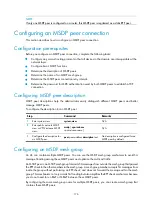
175
Enabling MSDP in a VPN instance
Step Command
Remarks
1.
Enter system view.
system-view
N/A
2.
Create a VPN instance and
enter VPN instance view.
ip vpn-instance
vpn-instance-name
For more information about this
command, see
MPLS Command
Reference
.
3.
Configure an RD for the VPN
instance.
route-distinguisher
route-distinguisher
No RD is configured by default.
For more information about this
command, see
MPLS Command
Reference
.
4.
Enable IP multicast routing.
multicast routing-enable
Disabled by default.
5.
Return to system view.
quit
N/A
6.
Enable MSDP and enter VPN
instance MSDP view.
msdp
vpn-instance
vpn-instance-name
Disabled by default.
Creating an MSDP peer connection
An MSDP peering relationship is identified by an address pair, namely, the address of the local MSDP
peer and that of the remote MSDP peer. An MSDP peer connection must be created on both devices that
are a pair of MSDP peers.
If an interface of the router is shared by an MSDP peer and a BGP or MBGP peer at the same time, HP
recommends that you configure the IP address of the MSDP peer the same as that of the BGP or MBGP
peer.
To create an MSDP peer connection:
Step Command
Remarks
1.
Enter system view.
system-view
N/A
2.
Enter public network MSDP view
or VPN instance MSDP view.
msdp
[
vpn-instance
vpn-instance-name
]
N/A
3.
Create an MSDP peer
connection.
peer
peer-address
connect-interface
interface-type interface-number
No MSDP peer connection
created by default.
Configuring a static RPF peer
Configuring static RPF peers can avoid RPF check for SA messages.
To configure a static RPF peer:
Step Command
Remarks
1.
Enter system view.
system-view
N/A
2.
Enter public network MSDP view
or VPN instance MSDP view.
msdp
[
vpn-instance
vpn-instance-name
]
N/A
3.
Configure a static RPF peer.
static-rpf-peer
peer-address
[
rp-policy
ip-prefix-name
]
No static RPF peer configured by
default.






























